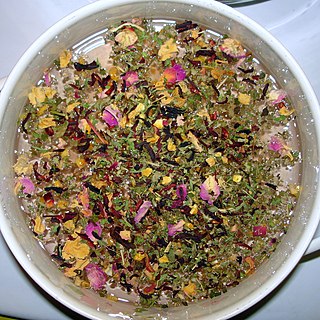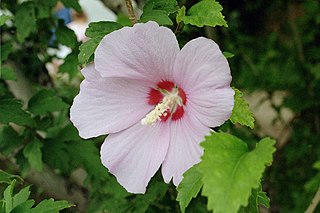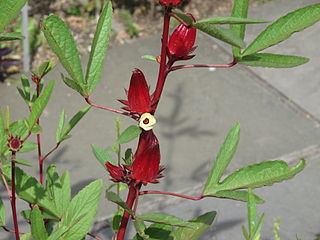
Herbal teas, also known as herbal infusions and less commonly called tisanes, are beverages made from the infusion or decoction of herbs, spices, or other plant material in hot water; they do not usually contain any true tea. Often herb tea, or the plain term tea, is used as a reference to all sorts of herbal teas. Many herbs used in teas/tisanes are also used in herbal medicine and in folk medicine. Some herbal blends contain true tea.

Hibiscus is a genus of flowering plants in the mallow family, Malvaceae. The genus is quite large, comprising several hundred species that are native to warm temperate, subtropical and tropical regions throughout the world. Member species are renowned for their large, showy flowers and those species are commonly known simply as "hibiscus", or less widely known as rose mallow.

Hibiscus syriacus is a species of flowering plant in the mallow family, Malvaceae. It is native to areas of east Asia, but widely introduced elsewhere, including much of Europe and North America. It was given the epithet syriacus because it had been collected from gardens in Syria. Common names include the rose of Sharon,, Syrian ketmia, shrub althea (or simply althea), and rose mallow. It is the national flower of South Korea and is mentioned in the South Korean national anthem.

Hibiscus × rosa-sinensis, known colloquially as Chinese hibiscus, China rose, Hawaiian hibiscus, rose mallow and shoeblack plant, is a cultigen of tropical hibiscus, a flowering plant in the Hibisceae tribe of the family Malvaceae. It was created in cultivation in the west Pacific from the species Hibiscus cooperi and Hibiscus kaute. It is widely cultivated as an ornamental plant in the tropics and subtropics.
Hawaiian hibiscus are seven species of hibiscus native to Hawaii. The yellow hibiscus is Hawaii's state flower. Most commonly grown as ornamental plants in the Hawaiian Islands are the non-native Chinese hibiscus and its numerous hybrids, though the native Hibiscus arnottianus is occasionally planted.

Hibiscus tiliaceus, commonly known as the sea hibiscus or coast cottonwood, is a species of flowering tree in the mallow family, Malvaceae, with a pantropical distribution along coastlines. It has also been introduced to Florida and New Zealand. It has been debated whether this species is native or introduced to Hawaii.

Roselle is a species of flowering plant in the genus Hibiscus that is native to Africa, most likely West Africa. In the 16th and early 17th centuries it was spread to Asia and the West Indies, where it has since become naturalized in many places. The stems are used for the production of bast fibre and the dried cranberry-tasting calyces are commonly steeped to make a popular infusion known by many names, including carcade.

Hibiscus trionum, commonly called flower-of-an-hour, bladder hibiscus, bladder ketmia, bladder weed, puarangi and venice mallow, is an annual plant native to the Old World tropics and subtropics. It has spread throughout southern Europe both as a weed and cultivated as a garden plant. It has been introduced to the United States as an ornamental where it has become naturalized as a weed of cropland and vacant land, particularly on disturbed ground.

The Hibiscus Coast is a populated area on a stretch of the Hauraki Gulf coast in New Zealand's Auckland Region. It has a population of 64,660, making it the 10th most populous urban area in New Zealand, and the second most populous in the Auckland Region, behind Auckland itself. As an urban area delineated by Statistics New Zealand, the Hibiscus Coast consists of Hatfields Beach, Orewa, Silverdale and Whangaparāoa Peninsula. The Auckland Council's Hibiscus Coast subdivision of the Hibiscus and Bays includes the neighbouring communities of Waiwera and Stillwater, and Milldale in Rodney, is also described as a part of the Hibiscus Coast.

Hibiscus grandiflorus, the large-flowered hibiscus or swamp rosemallow, is a species of flowering plant in the mallow family, Malvaceae. It Is native to the southern United States, from southeast Texas, to southern Florida as well as western Cuba. It is historically known from South Carolina. It favors wet habitats, especially tidal marshes, as well as lakeshores and wet pine savannas. Its flowers serve as a nectar source for hummingbirds, and its fruits provide seeds for other birds.

Hibiscus moscheutos, the rose mallow, swamp rose-mallow, crimsoneyed rosemallow, or eastern rosemallow, is a species of flowering plant in the family Malvaceae. It is a cold-hardy perennial wetland plant that can grow in large colonies. The hirsute leaves are of variable morphology, but are commonly deltoidal in shape with up to three lobes. It is found in wetlands and along the riverine systems of the eastern United States from Texas to the Atlantic states, its territory extending northward to southern Ontario.

Abelmoschus manihot, commonly known as aibika, is a flowering plant in the family Malvaceae. It is a tropical subshrub or shrub native to the Indian subcontinent, Indochina, central and southern China, Malesia, New Guinea, and Queensland. It is cultivated and eaten as a leaf vegetable, among other uses. It was previously classified as a species of Hibiscus but is now categorized under the genus Abelmoschus. This plant is also referred to as the sunset muskmallow, sunset hibiscus, or hibiscus manihot.

Neoveitchia is a genus of palm trees. It contains two known species, native to certain islands in the western Pacific:
Astronidium is a genus of plants in family Melastomataceae. It contains the following species :
Gardenia storckii, locally known as Mbolovatu or Ndrenga, is a species of flowering plant in the family Rubiaceae. It is the only gardenia occurring abundantly in the forested area of Serua Province in southeastern Viti Levu, to which its range is confined. It has been noted in dense, dry, or secondary forest as a slender tree 2-15m high and with a trunk to 14 cm in diameter. Flowers have been obtained in January through March, and fruits between April and November. It produces an abundance of latex. The resiniferous buds are used for chewing, and an extract of the roots is used medicinally for constipation.
Lyndley Alan Craven was a botanist who became the Principal Research Scientist of the Australian National Herbarium.

Roselle juice, known as bissap, wonjo, foléré, dabileni, tsobo, zobo, siiloo, soborodo or Sobolo in parts of Africa, karkade in Egypt, sorrel in the Caribbean, and agua de Jamaica in Mexico, is a drink made out of the flowers of the roselle plant, a species of Hibiscus. Although generally the "juice" is sweetened and chilled, it is technically an infusion and when served hot can also be referred to as hibiscus tea.

Hibiscus sturtii commonly known as "hill hibiscus",is a flowering plant in the family Malvaceae. It is a small shrub with pink, mauve or white flowers, hairy grey-green leaves and is endemic to Australia. Two forms are recognized; var. sturtii and var. muelleri.













